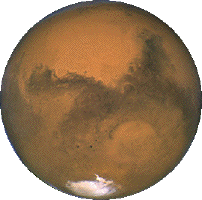
|
Mars Emission Model Tool |

|

|
Mars Emission Model Tool |

|
This is a tool set up to help those interested in the prediction of
the emission of Mars at IR and longer wavelengths. The model was
originally written by Don Rudy while a graduate student at Caltech,
and is described in:
Rudy et al. 1987 and
Muhleman & Berge 1991
The model was based on data taken at the VLA
in the A-configuration (most spread out - maximum baselines of
~36 km). The data were calibrated in flux density with observations
of 3C286, using the
Baars et al. 1977 flux density scale. Images were made, averaged over
time (so longitudinally smeared). These maps were then fit with a
full thermophysical model, fitting for a dielectric constant
separately for each of the wavelengths, a radio absorption length
common to both wavelengths, all as a function of latitude. A
whole-disk average dielectric constant was also fitted for, which is
independent of the flux density scale (as it relies on the
polarization response). These bulk properties were then fed into a
much more sophisticated thermophysical model which used results from
Viking (thermal inertia and albedo as a function of location), and
derived a surface and subsurface temperature profile as a function of
both longitude (7.5 deg bins) and latitude (5 deg bins). This was
done for a suite of models of varying electrical and thermal
parameters, and then a best fit to the maps was performed to get the
best fit parameters on the above grid. At the time, the north polar
seasonal CO2 cap was large, and easily seen in the images,
so they also fit for the effective thermal parameters of the
CO2 caps.
Since the original model, it has been updated to include surface
roughness effects, proper sub-pixel gridding, and potential
resolution of the disk by whatever antenna might be used to observe
it. It has also had the WMAP correction applied (see the description
in
Perley & Butler 2013 which is based on the WMAP observations
described in
Weiland et al. 2011).
This model has been commonly used to calibrate observations in the
millimeter and submillimeter wavelength regions, and seems to work
quite well. There are, however, a number of caveats that should be
kept in mind when applying it:


Last Modified on 2023-Apr-12